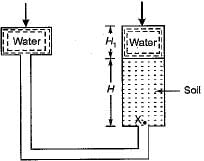Test: Principle of Effective Stress, Capillarity & Permeability - 1 - Civil Engineering (CE) MCQ
10 Questions MCQ Test - Test: Principle of Effective Stress, Capillarity & Permeability - 1
In a falling head permeability test on a soil, the time taken for the head to fall from h0 to h1 is t. The test is repeated with same initial head h0, the final head h' is noted in time t/2. Which one of the following equations gives the relation between h', h0 and h1?
Approximate ratios of the permeabilities of two clean soils having D10 = 0,6 mm and D10 = 0.3 mm respectively is
Which one of the following expressions represents the shear strength of soil at point X? Angle of shear resistance of soil is ϕ and symbols γw' γsat' γsub' γdry stand for unit weights of water, saturated soil, submerged soil and dry soil respectively.


A stratified soil deposit has three layers of thicknesses: z1 = 4, z2 = 1, z3 = 2 units and the corresponding permeabilities of k1 = 2, k2 = 1 and k3 = 4 units, respectively. The average permeability perpendicular to the bedding planes will be
In the case of stratified soil layers, the best equation that can be adopted for computing the pressure distribution is
The permeability of a soil sample varies (Where d = grain size)
In the situation shown in the given figure, the coefficient of permeability of the soil is 10-3cm/s. The discharge in one minute will be

Effective stress in a soil is the stress carried by the
The coefficient of permeability increases when
Which of the following methods is best suited for the determination of permeability of coarse grained soils?























